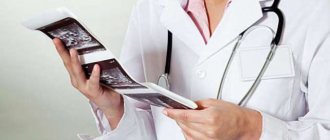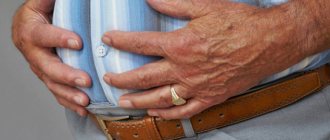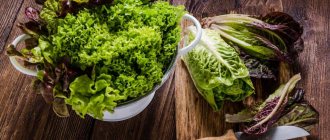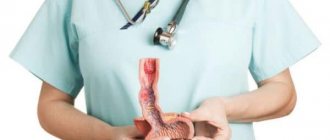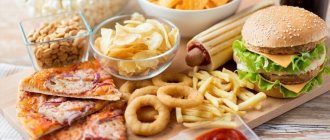Does your stomach hurt under your ribs? Pain in the upper abdomen under the ribs is a common symptom, especially characteristic of the following pathologies:
- Gastritis;
- Stomach and duodenal ulcers;
- Pancreatitis;
- Cholecystitis.
Cuts under the ribs on the right side are also characteristic of liver diseases. Lung pathology is indicated by subcostal pneumalgia, occurring on the right, left, in the middle, and aggravated by coughing. The same floating pain under the ribs is also characteristic of vegetative-vascular dystonia. This article will discuss pain in the upper abdomen that is related to dysfunction of the digestive system.
What is a stomach cramp?
Spasms in the stomach are a convulsive contraction of the developed muscle layer, consisting of smooth muscle fibers, and are a universal reaction in diseases of the hollow organs. Unlike skeletal muscles, which consist of striated muscles, they obey the autonomic nervous system, so their contraction does not depend on the person. With normal physiology, we do not feel the work of the stomach, but for various reasons, motor function disorders occur, which cause discomfort and pain. This condition is called gastrospasm.
“The autonomic nervous system is a section of the nervous system that regulates the activity of internal organs, endocrine and exocrine glands, blood and lymphatic vessels” - Wikipedia.
Spasmodic contraction can occur in any part of the stomach, but most often occurs in the antrum and pyloric area. Due to their location, these sections are drawn into the process due to deviations not only of the stomach (usually peptic ulcer disease), but also of other abdominal organs (gallbladder, appendix, pancreas).
Types of pain and possible diseases
By dividing the pain according to the intensity of its manifestations and the exact location of its location, it is possible to determine possible diseases.
Cutting pain on the left abdominal wall can be caused by:
- burn from alkali or acid;
- food poisoning.
Dull, weak, wave-like pain and a feeling of heaviness and fullness in the epigastric area indicate:
- gastritis;
- pyloric stenosis;
- stomach cancer;
- peptic ulcer (chronic phase).
Severe pain indicates an acute ulcer or exacerbation of chronic pathology of the stomach and duodenum.
When acute pinpoint stabbing pain occurs, perforation of the ulcer with release of stomach contents into the abdominal cavity or an exacerbation of another chronic disease is suspected:
- acute pancreatitis;
- colic with spasm of the smooth muscles of the gallbladder during the period of stone retention;
- peritonitis;
- colon perforation;
- liver rupture.
If pain occurs in the upper abdomen and is accompanied by diarrhea due to disruption of the digestion and absorption process, suspect:
- stomach ulcer;
- pancreatitis;
- cholecystitis;
- irritable bowel syndrome.
Painful sensations under the ribs on the upper left, in the presence of fever, can be observed in any inflammatory processes or food poisoning:
- for gastritis (not higher than 38 °C);
- stomach ulcer (more than 38 °C);
- acute pancreatitis (fever with rapidly changing indicators);
- food poisoning (more than 39 °C - depends on the type of microbe that provoked the process).
Causes
The causes of stomach cramps are poor diet, alcohol abuse, chronic gastritis, etc. All of them are divided into two groups: functional and organic.
Functional
They appear both without any pathology and together with it. Similar spasms occur in middle-aged people, schoolchildren, and students. Strongly related to lifestyle, ecology, emotional state. It happens that an obvious cause of functional disorders cannot be detected.
- The most common cause is prolonged stress.
- Lack of adequate nutrition.
- Genetic predisposition.
- Pathogen intoxication.
- Prolonged hypothermia.
- Vascular disorders in the abdominal cavity.
- Metabolic disorders.
- Alcoholism, smoking, excessive caffeine consumption.
- Some medications cause gastrointestinal spasms.
- Mechanical impact, rough food.
- Food allergic reactions.
- Accumulation of gases in the stomach.
- Parasitic infestation.
One of the reasons may be aerophagia - excessive swallowing of air when eating or talking.
There is such a thing as hunger pains (spasms), which, as you might guess, occur with prolonged refusal to eat. This is especially painful with ulcerative lesions. You can stop this condition by simply eating something. Interestingly, hunger pains originate in the brain; this is a signal from the body to a lack of food, and therefore energy for existence.
Functional disorders usually depend on the individual characteristics of the organism. Unfavorable factors can include neuroses, neurasthenia, and increased emotionality.
Organic
As a rule, they occur at older ages and imply organic changes in tissues. Often they are serious diseases in themselves:
- Gastritis. Occur at the moment of exacerbation, caused by the intake of spicy or sour foods. In severe episodes it is accompanied by vomiting.
- Peptic ulcer disease. Cramps appear after eating, especially provoking food or alcohol. Accompanying symptoms include heartburn and sour belching.
- Exacerbation of pancreatitis or pancreatic colic caused by alcohol or fatty foods. A rise in temperature is possible, then hospitalization and a full examination are advisable.
- Gastroduodenitis.
- Erosive lesions of the stomach walls.
- Imbalance of hydrochloric acid production.
One of the ways to determine the nature of the spasm is to intravenously or subcutaneously administer strong myotropic drugs (atropine, dibazole) to the patient. If the deformation of the stomach does not disappear with the help of medications, or does not disappear enough, most often this indicates an organic cause.
Pain in the upper abdomen: causes, diagnosis, treatment, medications
Among the direct indications for hospitalization in a surgical hospital, not the least place is occupied by complaints of acute pain in the upper abdomen. Some of them are completely justified and after a thorough examination, doctors identify in such patients a serious pathology of the abdominal organs, requiring intensive and sometimes surgical treatment.
However, in other cases, patients are discharged almost the next day, with a recommendation to be observed by a local physician at their place of residence. The bewilderment of these people who had to endure a very difficult time of waiting for an ambulance and staying within hospital walls is understandable.
In this article we will talk about why pain in the upper abdomen occurs and what to do about it.
Briefly about the anatomy of the epigastrium
Epigastric organs
The upper part of the abdomen, located just above the navel, is called the epigastrium in medical literature (from the Greek words “epi” - “above” and “gaster” - “belly”). From above this area is limited by the costal arches and the xiphoid process of the sternum, and from below by a conditional line passing through the lowest points of the edges of the X ribs.
The immediate causes of pain in the upper abdomen can be both organs located in this part of the abdominal cavity, as well as nerve fibers and muscles. Most often, the stomach above the navel hurts due to pathology :
- Stomach.
- Duodenum.
- Pancreas.
- Gallbladder and bile ducts.
However, sometimes doctors have to deal with complex cases of pain in the upper abdomen, when it is not caused by pathology of the abdominal cavity.
Diseases of the stomach and duodenum
This is the most common cause of aching and nagging pain in the upper abdomen, as well as other complaints that make up gastric dyspepsia syndrome . This symptom complex is caused by the pathology of the stomach and duodenum and includes:
- Discomfort in the upper abdomen, which occurs both on its own and in connection with food intake.
- Nausea, sometimes vomiting of recently eaten food.
- Heaviness after eating.
- Belching is sour, bitter and rotten.
- Regurgitation, or a kind of analogue of regurgitation in adults.
- Feeling of early satiety, and many other symptoms.
These clinical manifestations, including pain in the upper abdomen, fully describe the picture of chronic gastritis - one of the most common diseases of our time. The causes of this pathology are:
- long-term errors in diet;
- frequent intestinal infections;
- hereditary predisposition;
- autoimmune processes;
- carriage of the bacterium Helicobater pylori.
The latter is the main culprit of gastric ulcer . The disease can be asymptomatic, but most often with an ulcer, patients complain of pain in the upper abdomen that occurs during or half an hour after eating.
This differs from a duodenal ulcer , in which pain occurs on an empty stomach and at night - such patients, as a rule, love to eat and they perceive food as a pain reliever.
In the absence of proper treatment, the ulcer can be complicated by extremely dangerous pathologies that require urgent surgical care:
- Perforation or perforation of an ulcer . In this case, a through hole is formed in the wall of the hollow organ, through which the entire contents of the digestive tract penetrates into the abdominal cavity and causes peritonitis. Clinically, this condition is manifested by dagger pain in the upper abdomen, sharp tension in the muscles of the abdominal wall and a rapid deterioration in general well-being.
- Penetration of an ulcer or penetration of an ulcer into nearby organs. The pancreas is most often affected and clinically this condition manifests itself in almost the same way as perforation. But the described complaints are quickly joined by symptoms of acute pancreatitis, including girdle pain in the solar plexus area.
- Bleeding from the bottom of the ulcer , which can be either minor or very pronounced. This complication is manifested by weakness, low blood pressure, bloody vomiting or melena (smelly, tarry stool). Paradoxically, often with the development of bleeding, stomach pain is significantly relieved.
- Stricture or the formation of a pronounced narrowing of the stomach as a result of scarring of the ulcer. Clinically, this is manifested by faster satiety, vomiting of recently eaten food, pain above the navel and rapid weight loss.
The most serious reason why the upper abdomen may hurt is stomach cancer . Unfortunately, externally it often looks like an ulcer, including clinically, and final diagnosis is possible only on the basis of gastroscopy with biopsy.
If a middle-aged or older person experiences symptoms of a peptic ulcer, a prolonged increase in temperature (up to 37-37.9 degrees), loss of appetite and weight loss. Then he definitely needs to be examined for cancer.
Pathology of the pancreas
Another common cause of discomfort in the epigastric region is acute and chronic diseases of the pancreas. Three pathologies are of greatest importance here.
Acute pancreatitis , or an acute inflammatory process in the tissue of the pancreas, is accompanied by sharp, often girdling abdominal pain in the solar plexus area, repeated vomiting and a rapid deterioration in general condition. The causes of this disease are:
- Alcohol abuse and improper use of alcoholic beverages (for example, combining lard or other very fatty foods with vodka).
- Addiction to energy drinks and alcoholic cocktails.
- Taking certain medications (such as anticonvulsants for epilepsy and emotional disorders).
- Gallstone disease and some other conditions.
If acute pancreatitis develops, the patient should be immediately hospitalized in a surgical hospital to prevent the development of pancreatic necrosis or complete necrosis of the organ.
Dull aching pain in the upper abdomen, especially if it is accompanied by weight loss and frequent loose stools, may indicate chronic pancreatitis .
With this disease, the function of the organ is reduced to one degree or another, and first of all, the process of breaking down dietary fats is disrupted. They are excreted unchanged from the body and lead to steatorrhea - loose, foul-smelling stool, in which feces are poorly flushed from the walls of the toilet.
A very serious cause of pain in the upper abdomen is pancreatic cancer . This disease is extremely difficult because the tumor mechanically compresses the common bile duct. In patients with pancreatic cancer, the digestive processes are severely disrupted, jaundice with lightening of the stool and typical symptoms of a malignant process are observed.
Diseases of the biliary tract
In some patients, diseases of the gallbladder and biliary tract may be accompanied by acute and prolonged pain in the abdomen above the navel. Although these diseases are more characterized by the localization of pain in the left hypochondrium.
Most often, the upper abdomen hurts due to cholelithiasis , a disease characterized by the formation of hard stones in the lumen of the gallbladder and bile ducts.
When one of them begins to pass through the ducts, it mechanically injures their wall and causes excruciating and unbearable pain, which is called biliary or hepatic colic . The pain syndrome can be localized both in the left hypochondrium and in the upper abdomen under the ribs, and if it appears, you should immediately consult a doctor.
Rare causes of upper abdominal pain
It is not always possible to establish the reason why a particular patient has pain in the upper abdomen. Often patients do not understand why they undergo “extra” tests, such as ECG, chest x-ray and detailed urine tests. However, there are reasonable reasons for everything:
- In older people, acute pain above the navel may be the first signal of a myocardial infarction . Especially if there is a sharp decrease in blood pressure and sweating. Most often, this situation occurs in patients suffering from diabetes mellitus, since the functioning of the autonomic nervous system is disrupted due to impaired glucose metabolism.
- Sometimes pain in the upper abdomen is associated with pleurisy or acute inflammation of the pleura - the membrane surrounding the lungs. This is a complication of severe pneumonia, although there may be other reasons for the development of pleurisy.
- In difficult cases, when the patient, in addition to cramping pain in the upper abdomen, experiences severe watery diarrhea, attacks of suffocation, a feeling of flushing in the face and trembling of the hands, one can suspect carcinoid syndrome - a specific set of symptoms that occurs when there is a malignant neuroendocrine tumor in the body.
There are other reasons for the appearance of pain in the epigastrium, but they all require in-depth laboratory and instrumental diagnostics.
What to do if your stomach hurts in the upper abdomen
Epigastric pain is a dangerous symptom that you should never turn a blind eye to. Since very often its cause is acute surgical pathology, the slightest delay in seeing a doctor can lead to very sad consequences.
Therefore, if a sharp acute pain appears in the abdomen above the navel, you should immediately call an ambulance, and to reduce the pain, you can take No-Shpu.
Patients with chronic diseases of the digestive system (chronic gastritis or pancreatitis) first of all need to follow a strict diet.
Spicy, fried and sour foods are not allowed in the daily diet. It is necessary to limit the consumption of smoked meats, spices, as well as sauces and other seasonings.
Meals should be frequent, at least 4-5 times a day and divided into small portions. If, against the background of chronic gastritis, the stomach suddenly hurts in the stomach area, then to reduce discomfort you should take antacid medications (for example, phosphalugel).
If, based on the results of the examination, a diagnosis of gastric ulcer was made, then intensive eradication therapy . It is aimed at destroying Helicobacter pylori and normalizing the acidity of gastric juice.
The treatment regimen should be selected by a gastroenterologist or therapist, but usually it combines 3-4 drugs, including:
- Antibiotic (from the group of penicillins, macrolides, tetracyclines or metronidazole);
- A proton pump inhibitor (omez, esomeprazole, lansoprazole, rabeprazole and others) or bismuth preparations (for example, De-Nol).
Therapy should be continued continuously for at least 7 days, after which a repeat gastroscopy should be done.
Source: https://zhivotu.net/bol-vverhu-zhivota/
Symptoms
The main unpleasant symptoms of spasms are associated with visceral pain. Particularly dangerous are cramping pains in the stomach area, radiating to the lower back or navel, accompanied by attacks of nausea, vomiting, and a feeling of weakness throughout the body.
Visceral pain is called when it is localized in the internal organs.
Painful sensations appear due to compression of the vessels located in the wall of the hollow organ (ischemia occurs - insufficient blood flow to the tissues). Their character is different and varies from mild tingling to many hours of suffering with loss of ability to work. Individually, as a response to sharp spasms, dizziness, weakness, and diarrhea are observed.
The abdominal muscles may also experience spasms. In this case, there is a desire to lie down with your knees pulled up to your chin (in a ball). This position helps relieve muscle tension and pain decreases slightly.
Dangerous symptoms and first aid
There are symptoms that may accompany acute spasms; if they appear, it is recommended to immediately take corrective measures or call an ambulance:
- A sharp increase in body temperature.
- Pallor of the skin.
- Blood in vomit.
- The acute pain does not subside for several hours.
- The pain began to radiate to the chest and neck.
- Sudden decrease in blood pressure.
If at least one of the described symptoms is noticed, urgent hospitalization is necessary. After calling an ambulance, you need to take a position that will be most comfortable and will ease the pain. It is not advisable to eat or drink anything. Doctors do not recommend using painkillers, since further diagnosis of the cause of the spasm is greatly complicated.
During a spasm, do not put pressure on the stomach or navel area.
The best means
You can do without medication if pain in the abdominal area is not accompanied by vomiting, bleeding or high fever. It usually goes away after some time. To relieve abdominal pain, it is recommended to use antacids. Some of them can be purchased in pharmacies without a doctor's prescription. For example, “Maalox”, “Almagel” or “Phosphalugel”. The listed medications do a good job of eliminating pain. But they can only be used if the pain is actually directly related to problems of the digestive tract. If discomfort in the abdominal area occurs due to food poisoning or drug overdose, then activated carbon will be the best remedy.
Diagnostics
Only a full examination of the digestive organs and sampling by a gastroenterologist will give an answer to the cause of gastrospasm. First of all, during an in-person examination, the doctor will palpate the abdominal cavity and conduct a survey, this will help assess the approximate picture and prescribe a number of tests:
- Examination of blood from a vein.
- Analysis of stool for the presence of occult blood.
- Ultrasound examination of the abdominal cavity (ultrasound).
- Examination using an endoscope.
- Radiography evaluates the shape and size of the object, the state of muscle tone, sphincters and other indicators.
Medications
Among medications in the treatment of spasms, antispasmodics occupy a leading place. But you need to keep in mind that they only eliminate the symptom, but do not remove the cause of the pathology; long-term use without a doctor’s prescription can lead to dire consequences. Usually they are used either for a one-time dose or as prescribed by a doctor in courses.
- No-shpa. The most recognizable drug among antispasmodics. The recommended one-time dosage is 80 mg. Causes relaxation of smooth muscle tissue not only of the digestive tract, but also of other muscles, as a result it can cause a decrease in pressure and weakness.
- Papaverine. Available in suppositories and tablets. An old drug with many side effects, rarely used.
- Duspatalin. A more modern medicine that selectively targets stomach and other spasms of the digestive tract.
- Buskopan. The most fast-acting antispasmodic. Specializes in gastrointestinal pain. Contraindicated during pregnancy.
- Meteospasmil. Complex drug, a strong antispasmodic and carminative.
It is important to know that antispasmodics and painkillers are contraindicated in acute conditions until the cause is determined.
What should you not take?
It is forbidden to take Aspirin or Ibuprofen if you have an ulcer or liver problems. They act as an irritant to the mucous membranes, and the pain will only intensify. If a woman experiences stabbing pain during pregnancy, then experts recommend that it is best to refrain from using any medications. Each of them contains certain chemical elements that have a negative impact on the further development of the fetus. The most suitable option is a homeopathic remedy.

ethnoscience
Often, spasms can be relieved with folk remedies at home. You need to understand that this is a fairly common symptom and it is not always worth resorting to medications or calling a doctor. First of all, you should worry less; a spastic state often occurs due to nervousness.

The best solution is to brew chamomile tea, it is ideal for cramps. It has calming and antidepressant properties, which will calm the nervous system. Normalizes the functions of the gastrointestinal tract, relaxes the smooth muscles of the stomach, and has a mild analgesic effect. Drinking fluids in itself should have a positive effect.
Write in the comments.
Feel free to understand the problem that interests you together. >>>
One tablespoon of chamomile flowers is poured into 200 ml of hot water, left until cool, usually 15–30 minutes, and consumed half a glass 3-4 times a day.
Oil is prepared from chamomile by filling a container with flowers, pouring vegetable oil over it, sealing it tightly with a lid and leaving for a month, sometimes shaking the contents. After straining, take a teaspoon 2-3 times on an empty stomach.
Use honey diluted in warm water, it relaxes the walls of the stomach and relieves spasms, take a course for 30 days. In the complex, combine with peppermint, adding a teaspoon of tincture per glass.
Nutrition and prevention
The main factors in the development of spasms are bad habits and nervous strain; getting rid of them will be the best treatment. Spend more time walking, playing sports, and reduce or completely eliminate your consumption of caffeine, nicotine and alcohol. It will be useful to accustom yourself to eat more often, in small portions, chewing food thoroughly, and to drink enough water throughout the day. It may be worth brewing soothing infusions of herbal origin.

While at home, taking a warm bath helps to relax the tone of the stomach. The water temperature should be 34-36 degrees, take it for 15–20 minutes.
Do breathing exercises. Take a comfortable position (sitting or reclining) and inhale slowly through your nose for 4-5 seconds. Hold your breath for a couple of moments, then exhale smoothly through your mouth, repeat 10–15 times. This allows you to relax the abdominal muscles and internal organs. Doing strength exercises on the abs is prohibited; this will only aggravate the overall picture.
A diet for people suffering from constant cramps includes complete removal of provoking foods from the diet: spicy, pickled, smoked, fried, sour, salty. It is recommended to eat freshly prepared meals.
Dairy and vegetable soups, thick porridges, non-sour fruits, boiled meat and fish, and yesterday's bread are suitable. It is advisable to exclude tea and coffee, replacing them with herbal decoctions, compotes, and rose hips.
Causes of gastrospasm
According to the etiological factor (reason for development), gastric spasm is divided into exogenous disorders (occurs due to external influences on the gastric mucosa) and endogenous gastrospasm.
Exogenous gastrospasm develops:
– for nutritional disorders (frequent consumption of spicy, hot, smoked foods, irregular meals, eating dry food, abuse of spices, coarse fiber, mushrooms);
– when the body is exposed to aggressive factors: hot air, heavy lifting, vibration, medications (acetylsalicylic acid, corticosteroids), alcohol intoxication, nicotine;
– with helminthic infestation and other intoxications (heavy metal poisoning), exposure to ionizing radiation.
Endogenous gastrospasm (secondary)
develops against the background of various diseases:
- severe diseases of the nervous system;
- endocrinopathies;
- kidney and liver pathologies;
- malignant neoplasms;
- chronic infections (tuberculosis, purulent foci;
- pathologies of the heart and blood vessels.
Symptoms of gastrospasm
Pain syndrome
The clinical picture of gastrospasm is caused by increased motor activity of the stomach or tetanic spasm of the wall muscles and is characterized by the sudden onset of cramping pain in the upper abdomen, which does not have a clear dependence on food intake, but in most cases is associated with stress factors.
The localization of colic depends on the area where the spasm occurs:
– with spasm in the pyloric zone – pain occurs in the epigastrium;
– with true gastrospasm – under the xiphoid process.
Belching, heartburn
Prolonged gastrospasms cause disruption of the movement of the food bolus and retention of food in the stomach - this is often manifested by discomfort, pressure or heaviness in the stomach, which is accompanied by belching of food or air and/or heartburn.
In patients with neurasthenia and hysterical character traits (more often in women), aerophagia (swallowing air) occurs when eating quickly or during a conversation. Then belching of air and food occurs (sour - with increased acidity, bitter - when bile is thrown into the stomach), with prolonged stagnation of a food bolus in the stomach, belching occurs with the smell of rotten eggs as a result of the formation of ammonia and hydrogen sulfide (with an ulcer or malignant neoplasms).
With antiperistaltic contraction of the stomach muscles, heartburn develops, which is caused by prolonged irritation of the lower parts of the esophagus with gastric juice or stomach contents with increased acidity.
Nausea, less often vomiting
With constant and prolonged delay and disruption of the evacuation of food from the stomach to the intestines, constant nausea with single or repeated vomiting may develop due to irritation of the receptors of the gastric mucosa; vomiting is congestive in nature and in most cases alleviates the patient’s condition and relieves pain.
Signs of overstimulation of the vagus nerve
As a result of irritation of the vagus nerve, drooling, hypotension, pallor, bradycardia and cold sweats or diaphoresis occur.
Gastralgia
Inflammation of the stomach
Dull, or, on the contrary, sharp pain in the anterior hypochondrium of the abdominal cavity causes inflammation of the stomach with high or normal acidity. This pathology is characterized by the occurrence of painful sensations in a state of hunger, due to the fact that gastric juice irritates the inflamed gastric mucosa.
But eating does not alleviate the condition, but on the contrary, it can increase the pain, because after eating, the inflamed mucous membrane is irritated by the food taken, especially if it is hard and high in acids. Therefore, patients with gastritis are recommended to eat starch-containing soups, jelly and other dishes that envelop the walls of the stomach.
Gastritis with high acidity is also characterized by symptoms such as heartburn, unstable stools prone to constipation. Aching pain and a feeling of heaviness under the solar plexus indicate the presence of gastritis with low acidity. This condition is especially worse after eating.
One of the signs confirming this diagnosis may be belching something bitter, sour, or something eaten. Vomiting with this form of gastritis brings relief. Malabsorption leads to decreased body weight, increased sweating of the hands and feet, chronic anemia, and vitamin B12 deficiency.
Diagnosis of gastrospasm
Diagnosis of this pathology is based on collecting a medical history, complaints and examination of the patient.
Upon examination, symptoms of peristaltic movement (pathological peristalsis) in the form of a round shaft with subsequent retraction in the area of the left hypochondrium will be detected in the epigastric region. These symptoms can only be observed when there is food in the stomach. If there is no food in the stomach, this symptom can be caused by light tapping on the anterior abdominal wall in the stomach area.
If the development of gastrospasm is suspected, additional laboratory and instrumental methods for examining the patient are prescribed.
Source

Have you been struggling with GASTRITIS and ULCERS for many years without success?
“You will be amazed at how easy it is to cure gastritis and ulcers just by taking it every day...
Read more "
Acute pain in the stomach that occurs when bending forward is familiar to all people. Its reasons are quite varied. It can be caused by both pathological processes occurring in the main digestive organ and diseases of other organs located in close proximity to the stomach.
This article will discuss the main causes of pain when bending forward and accompanying symptoms.
In addition, special attention should be paid to methods of dealing with pain and the sequence of actions when it occurs.
Diseases that cause pain
Stomach colic accompanied by pain are signs of damage to the stomach or organs close to it:
- Gastritis – prolonged pain is felt after digesting sour or rough foods, and there is also a feeling of heaviness, weakness and nervousness.
- Stomach ulcer – 30% of patients may experience mild pain that occurs after eating; relapses of this disease are replaced by seasonal exacerbations.
- Duodenitis – projects pain from the small intestine to the stomach. In addition to stabbing and cutting pain in the stomach, inflammation of the intestinal tract is accompanied by hyperthermia, depression, vomiting and lightheadedness.
- Appendicitis - an attack begins with the appearance of stabbing pains in the stomach, later they shift to the iliac region on the right side. Signs: slight nausea, slight increase in temperature.
- Coronary heart disease (CHD) is a disorder of the blood supply to the myocardium, sometimes radiating to stabbing pain in the stomach area. Additional signs are shortness of breath, tachycardia, impotence.
Pathological processes in the main digestive organ
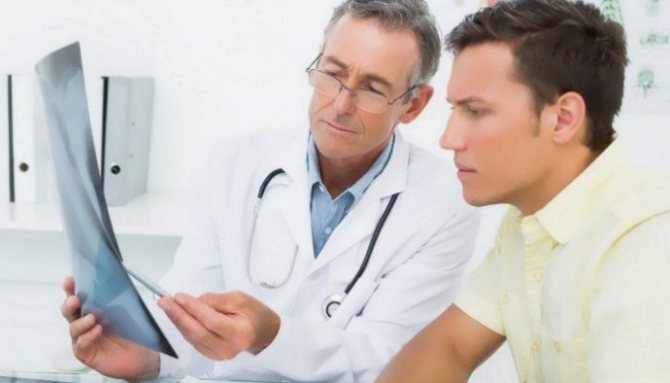
First of all, you should consider the causes of pain when bending forward, caused by pathological processes in the stomach. There are quite a few similar reasons, but the most likely of them are:
- acute gastritis . Stomach pain in acute gastritis does not occur spontaneously. Its manifestations are caused by a combination of several factors. For example, if you lean forward sharply after eating a fatty meal, pain will occur with a 100% probability;
- stomach ulcer . An ulcer of the main organ of the digestive system is a very dangerous disease. Ulcer pain can be of several types. The most dangerous are the dagger-like pain sensations that can occur, including when sharply bending forward. The danger of such a symptom lies in the fact that dagger pain, in most cases, indicates the formation of a hole in the stomach through which its contents can enter the abdominal cavity. This condition is deadly;
- functional disorders of the gastrointestinal tract. This state of the digestive system is probably familiar to every person who does not lead a healthy lifestyle. Disruption of the gastrointestinal tract can be caused by taking a heavy dose of drugs, alcohol, heavy food or nicotine. As a rule, in this condition, pain can be caused not only by bending, but also by any other sudden movement;
- intoxication . Poisoning or intoxication, food and non-food products, is also a fairly common cause of pain with any movement. The degree of pain directly depends on the severity of the poisoning;
- imbalance of intestinal microflora. A mass of different microorganisms are constantly present in the gastrointestinal tract of any person. An imbalance in their balance, caused by a number of factors, can lead to various consequences, including pain when bending over;
- food allergies and individual intolerance to certain foods . As a rule, this cause of pain is not widespread. Any person who has tried an unfamiliar dish or product and experienced not the most pleasant sensations, among which pain is far from the first place, is unlikely to decide to repeat the experiment.
Stomach and duodenal ulcers
Gastric ulcers are characterized by sharp pain localized in the left half of the hypochondrium.
Gastric and duodenal ulcers are characterized by sharp pain, localized in the left half of the hypochondrium, starting from the middle of the abdomen. Often discomfort occurs at night. The disease worsens in the off-season, that is, in spring or autumn. The pain sometimes radiates under the left rib, into the back and lower back. To alleviate the condition, the patient is forced to take a position that allows him to press the painful part of the abdomen:
- Lie on your stomach
- Sit on your haunches with your hands on your stomach,
- They press themselves against the table.
Read: A child has a stomach ache at night: possible causes of the problem
Ulcers, like gastritis, are characterized by “pain on an empty stomach”, which appears one and a half to three hours after eating. Physical stress and nervous disorder can be a provoking factor for the occurrence of pain. Antacids help in this condition. Some patients use a heating pad and soda solution.
Sometimes the pain occurs due to bleeding from the part of the stomach affected by the ulcer, and this can be dangerous. Additional symptoms indicating the presence of stomach and duodenal ulcers are heartburn, flatulence and constipation. With a long-term illness, patients lose weight, they develop headaches, weakness, and increased irritability.
Pathological processes occurring outside the main digestive organ
Stomach pain is a rather abstract definition. An ordinary person who does not have a medical education is unlikely to be able to say with one hundred percent certainty that it is his stomach that hurts. As a rule, pain localized in the epigastric region is considered gastric. Moreover, its cause may lie in pathologies occurring outside the main digestive organ. The most obvious causes of pain in the stomach when bending forward, not related to illnesses occurring in it, are:
- pancreatitis . Destruction of the pancreas in most cases is accompanied by acute pain, which can intensify with any movement, including bending;
- acute appendicitis . It is believed that pain during inflammation of the appendix is localized in the left side, but this is not so. Initially they are localized in the navel area, then they move to the entire abdomen and only after that to the left side. Any sudden movement can be their catalyst;
- malfunctions of the nervous system . In the human body, the work of all systems is interconnected. A sharp release of adrenaline into the blood can cause pain in the stomach. For example, a person who bends down to pick up something and sees something that frightens or worries him is quite capable of experiencing a sharp attack of pain in the stomach.
As mentioned above, stomach pain when bending forward is not the only symptom of the conditions described above. The other signs of pathologies listed above should be discussed in more detail.
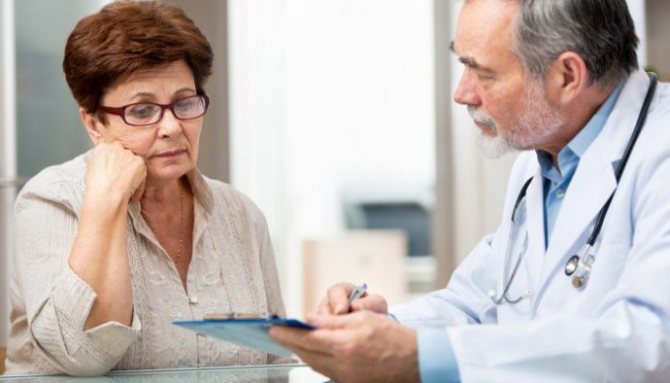
Associated symptoms
Together with the occurrence of pain, all of the above conditions and pathologies may be accompanied by:
- diarrhea;
- nausea;
- vomiting;
- constipation;
- general weakness of the body;
- headache;
- decreased performance, etc.
All symptoms can be presented, either together or separately. They can be either short-term or permanent.
Fennel
To reduce pain in the stomach, it is recommended to use a decoction of fennel seeds, which have antimicrobial and carminative effects. Pour a spoonful of fennel seeds into a small saucepan, pour in one and a half glasses of hot water, boil the mixture for three minutes, strain and cool. Use fennel infusion as tea if you have stomach pain.
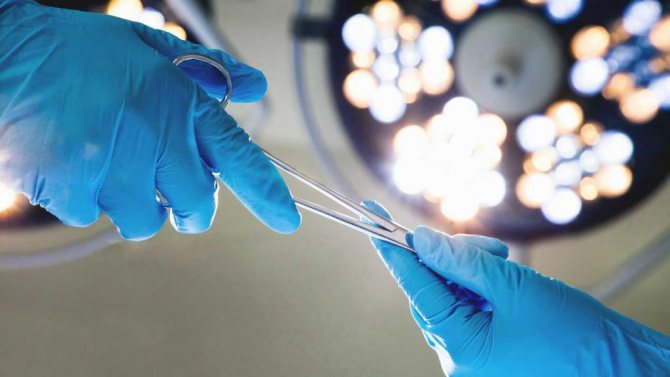
What to do if pain occurs?
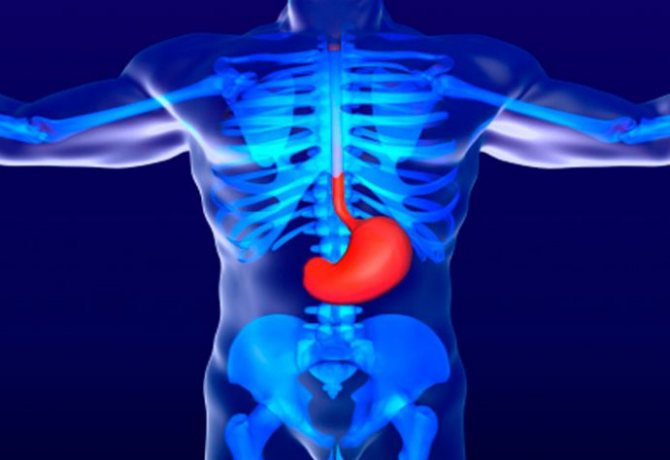
Pain that is short-term in nature, for example when overeating, will quickly go away on its own and does not need to be treated. All you need to do is take activated carbon at the rate of 1 tablet per 10 kilograms of weight.
If the pain does not subside, then it makes sense to take a painkiller. In case of unbearable pain, accompanied by fever and other symptoms mentioned above, you should call an ambulance. Perhaps the cause of their occurrence is quite serious and hospitalization will be required.
If the pain is not severe, but constant or appears periodically, for example, every time you bend forward, you should consult a gastroenterologist. Only a highly qualified specialist can correctly diagnose and prescribe treatment.
Source
Acute, dagger pain with perforation of the stomach and duodenum
Perforation of the stomach or duodenum is characterized by acute dagger pain.
Perforation of the stomach or duodenum is characterized by acute dagger pain. This pain forces the patient to assume the fetal position - lying on his side with his legs pressed to his stomach. At first it concentrates in the epigastric region, that is, “under the stomach,” but then moves to the right, under the last rib.
This is the contents of the stomach spilling into the abdominal cavity. After an acute attack, temporary relief may occur. If the patient does not receive timely treatment, the perforation will result in peritonitis, which will cause the patient’s death. Therefore, a patient diagnosed with a stomach and duodenal ulcer needs to be more attentive to his body.
And if acute stabbing pain occurs, immediately call an ambulance. Because in this situation there is only one way out - surgical intervention. Is it possible to avoid ulcerative perforation when the ulcer damages an organ through and through? Yes, you can, if you don’t let the disease progress and treat it in a timely manner, follow diets and all doctor’s instructions, take medicinal herbal infusions and decoctions, and avoid stress and anxiety.

